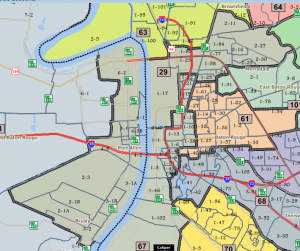Incumbent – Regina Barrow (D – Term Limited in 2015)
District Map
Vote History
|
2008 President |
||
| Current District | New District | |
| John McCain (R) | 1869 (10%) | 3728 (19%) |
| Barack Obama (D) | 16677 (89%) | 15763 (80%) |
| Others | 97 (1%) | 123 (1%) |
|
2008 Senate |
||
| Current District | New District | |
| Mary Landrieu (D) | 16472 (91%) | 16057 (84%) |
| John Kennedy (R) | 1442 (8%) | 2778 (15%) |
| Others | 173 (1%) | 199 (1%) |
|
2010 Senate |
||
| Current District | New District | |
| David Vitter (R) | 1108 (10%) | 2352 (20%) |
| Charlie Melancon (D) | 9383 (86%) | 9041 (76%) |
| Others | 479 (4%) | 538 (5%) |
|
2010 Lt Governor |
||
| Current District | New District | |
| Jay Dardenne (R) | 1589 (14%) | 2947 (25%) |
| Caroline Fayard (D) | 9371 (86%) | 8997 (75%) |
Current District
As far as redistricting years go, the 1991 reapportionment significantly impacted the partisan and racial makeup of the Louisiana Legislature. While about 10 new black majority districts were created, the remaining districts became more winnable for Republicans. House District 29 is one of those black majority districts which were created in 1991.
District 29 has a semicircular shape and contains black majority neighborhoods in both East and West Baton Rouge Parishes. In West Baton Rouge Parish, it includes the black section of Port Allen. As the district crosses into East Baton Rouge Parish just north of the Capitol, it travels up Scenic Highway to Airline to include the petrochemical plants which employ a lot of Baton Rougeans. Once it reaches Airline, it then travels down Airline all the way to Choctaw, picking up blue-collar neighborhoods along the way east of Airline. At Airline and Choctaw, the district then picks up the middle-class neighborhoods and industrial areas between Airline and Flannery Road along South Choctaw (Curiously, an area of town near Florida and Flannery known as “Little Vietnam” is in the district).
The demographics of the district are a good exhibit of the racial changes that have occurred in East Baton Rouge Parish, particularly in the areas north of Florida Boulevard. Areas near the plants on Scenic Highway became majority black in the 1970s as blue collar whites moved farther out. The neighborhoods along Choctaw saw significant racial changes in the 1980s and 1990s. The sum total of these changes is a district that was 77% black (by voter registration) when the district lines were last drawn; today, this district is 86% black.
These demographic changes were also reflected in the legislative representation the district has had. In the 1970s and 1980s, most of these precincts elected Woody Jenkins, who at the time was a conservative Democrat. However, after the 1991 reapportionment, his original district was pushed farther south into more conservative and affluent neighborhoods south of Florida Boulevard. A new state House district was then created from most of the areas he originally represented in the 1970s and 1980s. This newly created district elected black Democrat Sharon Weston Broome, and Rep. Broome (who back then was Sharon Weston) served for 14 years – when “Kip” Holden was elected Mayor/President of East Baton Rouge Parish in 2004, his state senate seat became vacant, and Rep. Broome was elected without opposition.
In the 2005 special election to replace Rep. Broome, another black Democrat, Regina Barrow, was elected, and was easily re-elected in 2007. She is allowed to serve one more term.
New District
Redistricting was a relatively painless affair in Baton Rouge, because robust population growth in the area combined with a general consensus that an additional black majority district needed to be created made the line drawing a non-controversial affair. However, the location of the new black majority district between Brookstown and Sherwood Forest caused major adjustments to be made to the district, which otherwise (with its 2% under population) could have been left alone.
The first change made in East Baton Rouge was that all areas south of Greenwell Street (neighborhoods like Park Forest, Bellaire, and Monticello) were placed in the new black majority district (District 101). The district also picked up Brownfields and a couple of precincts along Plank Road near Redemptorist High. In West Baton Rouge, the district picked up the rest of Port Allen, Brusly, and an area north of Port Allen near the “Old (US 190) Bridge.”
These changes slightly diluted the black voter registration from 86 to 77% of the district, and also increased the influence of West Baton Rouge Parish from 9 to 32% of the vote. However, these changes do not change the fact that you have a black majority district that is anchored in East Baton Rouge Parish. Rep. Barrow (or any other black Democrat) shouldn’t have any problems getting re-elected.


Sources…
[…]here are some links to sites that we link to because we think they are worth visiting[…]…
Just read this ……
some really nice and useful information on this internet site , also I think the design and style holds excellent features….